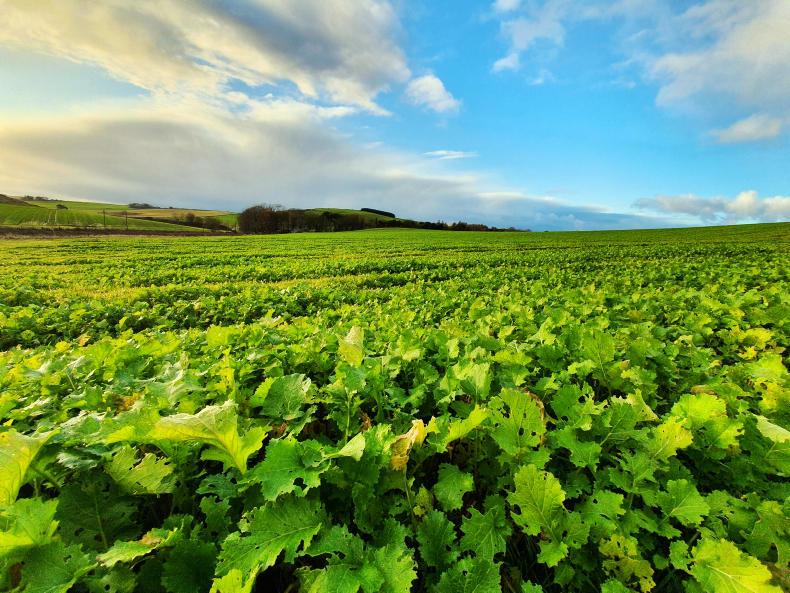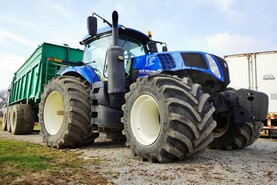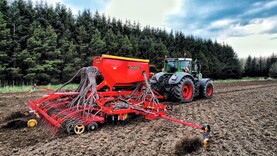A follow-up meeting to the stubble turnip sowing event took place at Arnage Farm near Ellon on Wednesday this week.
Controlling the cost of wintering stock is one of the key aims of the Biffen family at Mains of Arnage, Ellon, one of the ANM/Farmers Journal Farm Profit Programme Focus Farms.
After successfully trialling sheep and cattle on hybrid brassica and stubble turnips behind winter barley last year, the Biffen family decided to make greater use of forage crops this year.
This has three key benefits for the family:
Provides a cheaper source of winter feed for livestock and reduces the amount of time stock are housed.Allows a rest period for the grass fields during the winter months. Previously, the ewes would spend the winter on the grass. This resulted in a shortage of grass when required in spring, delaying turnout of livestock and adding to wintering costs. Breaks up the arable rotation on the farm and puts organic manure back in the system, increasing the overall soil organic matter levels on farm.This winter, there are three separate forage crops on the farm. In the spring, 6.5ha of fodder beet was established into a temporary grass field to winter the dry suckler cows.
Brassica
Late summer saw 6ha of hybrid brassica being established into a tired permanent pasture as part of the rejuvenation process.
This was seen as a great way to rejuvenate the under-productive field and get the added bonus of a winter forage crop prior to direct reseeding next spring.
A group of 24 in-calf heifers is currently grazing this crop, which should see them through until the end of December
A cut of silage was taken from the field before the crop was established and the bales were spaced out along one side of the field to be used to winter in-calf heifers.

Stubble turnip trial sowing plots at Arnage
A group of 24 in-calf heifers is currently grazing this crop, which should see them through until the end of December.
Finally, 10ha of stubble turnips were established directly into a winter barley stubble to winter ewes on.
This crop establishment was the subject of the previous meeting on the farm on 13 August. The stubble turnips were drilled with four different contractors’ direct drills:
Horsch Pronto supplied by Roger Glennie.Sim-tech Aitchison from John Stephen.Simba X-press cultivator with a broadcast bar from Eric Gibson.System Cameleon supplied by Murray Cooper.Strategy
Wednesday’s meeting allowed farmers to come and view the established plots, discuss grazing strategies and discuss the lessons learned.
Direct drilling was chosen for the stubble turnips to maximise timeliness post-harvest and reduce cost.
It also means that due to the lower level of surface disturbance, the ground should be able to carry the livestock better through winter.
Conditions at sowing in August were near perfect.
This is reflected in the success of crop establishment and comparable yields across the four machines.
Perhaps in a different season with different climatic conditions there might be a greater yield difference across systems. Table 1 details the costs and yields from each drill.
Yield
Each method achieved a substantial yield given the sowing date.
The crop could have been in about a week earlier and this would have had a positive effect on overall yield.
However, across the four methods yield per hectare only differed by 220kg.
Although each machine was set to sow at the same seed rate, some plots looked to have a greater plant density than others.
This did not translate to yield, however, as bulb size was greater on the plots with lower seed density.
What was evident in this situation was the benefit of the sub-soiling that was on the front of the Simba X-press.
This field has been in continuous arable for over 20 years. Soil compaction is an issue.
Although this establishment method was the most expensive, it could provide an excellent way to sub-soil the arable ground over the next few years as the forage crops move around the farm.
Ground conditions underfoot do feel much softer in this plot and this may have an effect on grazing and crop utilisation over the coming weeks.
However, it will be interesting to see if there are any yield differences in the spring barley crop that will be sown here next year.
Cost per day
Another point to note is that despite there being a difference of around £8/tDM (tonne dry matter) across the drills, this has little effect on the cost per day of keeping an animal on the crop.
Assuming a 70% inclusion of forage crop in the diet, an average dry ewe would eat around 0.75kg of dry matter of this per day, meaning a cost difference of less than 1p per ewe per day.
A 700kg dry suckler cow would be eating around 10kg of dry matter of this per day, meaning a cost difference of 8p per cow per day from the cheapest to most expensive cost/tDM.
A follow-up meeting to the stubble turnip sowing event took place at Arnage Farm near Ellon on Wednesday this week.
Controlling the cost of wintering stock is one of the key aims of the Biffen family at Mains of Arnage, Ellon, one of the ANM/Farmers Journal Farm Profit Programme Focus Farms.
After successfully trialling sheep and cattle on hybrid brassica and stubble turnips behind winter barley last year, the Biffen family decided to make greater use of forage crops this year.
This has three key benefits for the family:
Provides a cheaper source of winter feed for livestock and reduces the amount of time stock are housed.Allows a rest period for the grass fields during the winter months. Previously, the ewes would spend the winter on the grass. This resulted in a shortage of grass when required in spring, delaying turnout of livestock and adding to wintering costs. Breaks up the arable rotation on the farm and puts organic manure back in the system, increasing the overall soil organic matter levels on farm.This winter, there are three separate forage crops on the farm. In the spring, 6.5ha of fodder beet was established into a temporary grass field to winter the dry suckler cows.
Brassica
Late summer saw 6ha of hybrid brassica being established into a tired permanent pasture as part of the rejuvenation process.
This was seen as a great way to rejuvenate the under-productive field and get the added bonus of a winter forage crop prior to direct reseeding next spring.
A group of 24 in-calf heifers is currently grazing this crop, which should see them through until the end of December
A cut of silage was taken from the field before the crop was established and the bales were spaced out along one side of the field to be used to winter in-calf heifers.

Stubble turnip trial sowing plots at Arnage
A group of 24 in-calf heifers is currently grazing this crop, which should see them through until the end of December.
Finally, 10ha of stubble turnips were established directly into a winter barley stubble to winter ewes on.
This crop establishment was the subject of the previous meeting on the farm on 13 August. The stubble turnips were drilled with four different contractors’ direct drills:
Horsch Pronto supplied by Roger Glennie.Sim-tech Aitchison from John Stephen.Simba X-press cultivator with a broadcast bar from Eric Gibson.System Cameleon supplied by Murray Cooper.Strategy
Wednesday’s meeting allowed farmers to come and view the established plots, discuss grazing strategies and discuss the lessons learned.
Direct drilling was chosen for the stubble turnips to maximise timeliness post-harvest and reduce cost.
It also means that due to the lower level of surface disturbance, the ground should be able to carry the livestock better through winter.
Conditions at sowing in August were near perfect.
This is reflected in the success of crop establishment and comparable yields across the four machines.
Perhaps in a different season with different climatic conditions there might be a greater yield difference across systems. Table 1 details the costs and yields from each drill.
Yield
Each method achieved a substantial yield given the sowing date.
The crop could have been in about a week earlier and this would have had a positive effect on overall yield.
However, across the four methods yield per hectare only differed by 220kg.
Although each machine was set to sow at the same seed rate, some plots looked to have a greater plant density than others.
This did not translate to yield, however, as bulb size was greater on the plots with lower seed density.
What was evident in this situation was the benefit of the sub-soiling that was on the front of the Simba X-press.
This field has been in continuous arable for over 20 years. Soil compaction is an issue.
Although this establishment method was the most expensive, it could provide an excellent way to sub-soil the arable ground over the next few years as the forage crops move around the farm.
Ground conditions underfoot do feel much softer in this plot and this may have an effect on grazing and crop utilisation over the coming weeks.
However, it will be interesting to see if there are any yield differences in the spring barley crop that will be sown here next year.
Cost per day
Another point to note is that despite there being a difference of around £8/tDM (tonne dry matter) across the drills, this has little effect on the cost per day of keeping an animal on the crop.
Assuming a 70% inclusion of forage crop in the diet, an average dry ewe would eat around 0.75kg of dry matter of this per day, meaning a cost difference of less than 1p per ewe per day.
A 700kg dry suckler cow would be eating around 10kg of dry matter of this per day, meaning a cost difference of 8p per cow per day from the cheapest to most expensive cost/tDM.







 This is a subscriber-only article
This is a subscriber-only article











SHARING OPTIONS: